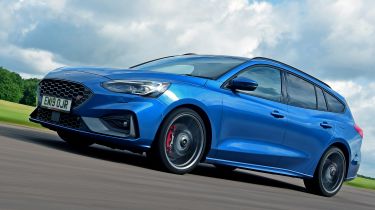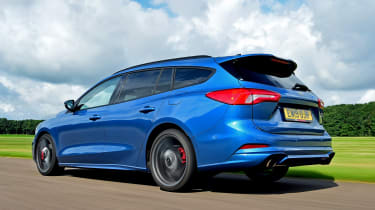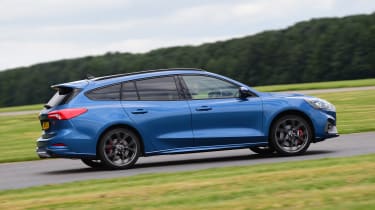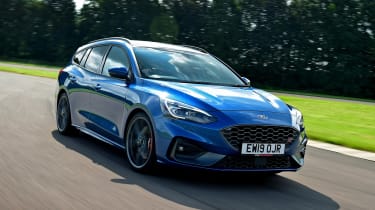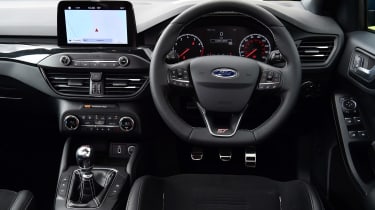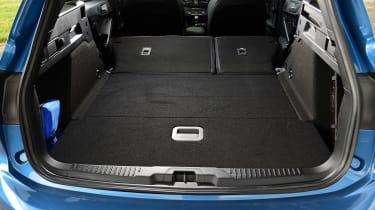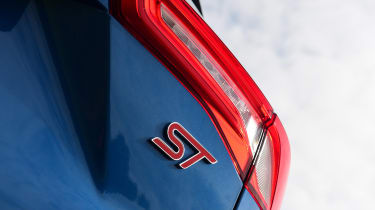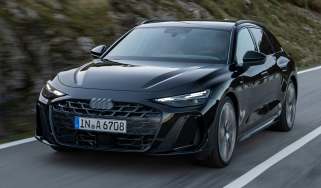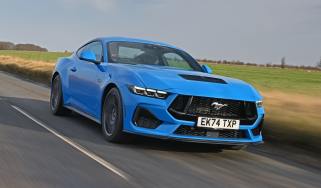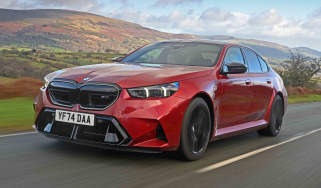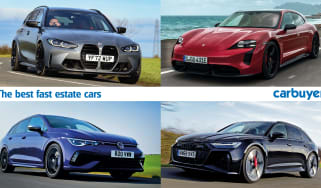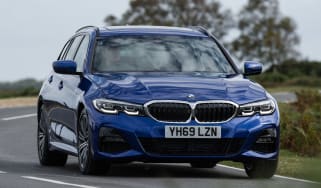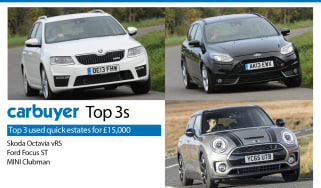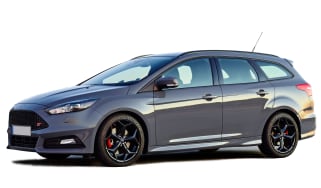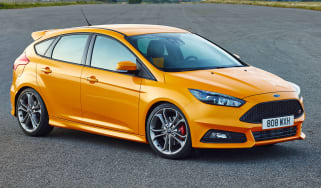Ford Focus ST Estate review
"The Ford Focus ST Estate is just as good to drive as the hatchback but has a much bigger boot"
Pros
- Big boot
- Fun to drive
- Advanced technology
Cons
- Firm ride
- Quite expensive
- Disappointing owner feedback
Verdict – is the Ford Focus ST estate a good car?
We already love the Ford Focus ST hatchback, but the estate version offers even more versatility for those who want a fun-to-drive car with the added practicality of a bigger boot. Stretching out the Focus ST into an estate car doesn’t impede too much on the winning hot-hatch formula, and improved technology over the older model makes it the most advanced Focus ST yet, but be aware that the sporty model’s firm ride means it’s not the most comfortable offering, and an expensive price tag might put some buyers off.
Ford Focus ST estate models, specs and alternative
If you’re a hot hatch fan but now have a family and need a bit more room, the Ford Focus ST Estate could be the car for you. There’s space for all the family inside, punchy performance and a lower-slung look than hot SUVs like the Cupra Ateca and Volkswagen T-Roc R.
The Focus ST was facelifted in October 2021, bringing tweaked styling – most noticeably the sharper, slimmer headlights and darkened rear lights. The Ford badge now sits on the front grille rather than above it, and new alloy wheel options were added, along with the striking Mean Green paint colour first offered on the Ford Puma ST. The Recaro sports seats were swapped for Ford-developed items in the update, and a much larger touchscreen than before now sits on the dashboard (complete with the latest version of Ford’s infotainment software.)
 The 10 best hot hatchbacks to buy in 2025
The 10 best hot hatchbacks to buy in 2025
Part of the Focus ST Estate’s sporty appeal is rooted in the fact that it shares so much with the hatchback and only weighs 35kg more. That means it feels virtually identical to drive, with pin-sharp reactions and incredibly quick steering helping it dive into corners at speed. In Sport mode the ride is fairly firm but the car feels more taut and agile as a result, giving you plenty of confidence when driving it quickly.
More reviews
The turbocharged 2.3-litre EcoBoost petrol engine with 276bhp feels just as potent in the estate, and manages to get the car from 0-62mph in 5.8 seconds, despite a lack of four-wheel drive. The petrol engine is rather thirsty, averaging around 30mpg during our test. Long-distance and company-car drivers could previously opt for the 187bhp diesel version instead but this has been discontinued. It wasn't quite as exciting but 50mpg and lower monthly bills made it a more practical proposition for many.
Of course, there's a lot more space in the boot than in the hatchback and despite its swooping bodywork, the ST Estate can rival the Skoda Octavia vRS Estate for luggage room. Not only that, a rear-end redesign has replaced the old centre-exit exhaust with a pair of tailpipes located on the sides of the rear bumper, meaning that the Focus ST can now be fitted with a tow bar.
Hot hatchbacks and estates can no longer appeal on performance grounds alone, and the ST Estate provides some luxury via its sporty interior, with part-leather sports seats, a heated steering wheel and a touchscreen. Standard equipment also includes adaptive LED headlights, lane keep assist and autonomous emergency braking - the safety systems helped the Focus score five stars in Euro NCAP crash tests. Ford owner satisfaction could be better; the brand came 25th out of 29 manufacturers in the 2022 Driver Power survey and the Focus didn’t feature in our list of the top 75 cars.
A price tag of just under £38,000 means that only hardcore driving fans are likely to see all the benefits of buying the Focus ST Estate over performance estate rivals like the Skoda Octavia vRS and the Cupra Leon Estate. It is more affordable than the faster Volkswagen Golf R estate, however.
MPG, running costs & CO2
The Focus ST Estate was originally available with either a petrol or diesel engine but the diesel was discontinued when the ST Estate was facelifted. The petrol certainly gets all the headlines and starring roles in videos but it's quite expensive to run.
Its 2.3-litre engine returns 35.3mpg according to Ford's official figures but this will drop further if you drive the ST Estate hard. In our test, we were able to achieve around 30mpg on longer journeys, with around 24-26mpg around town. Impressively, the economy is identical to the hatchback ST, so the added practicality of the Estate doesn't come with any real penalties.
When the diesel was available, it offered up to 50.4mpg, so it was better suited to anyone driving lots of motorway miles or towing. It was also more attractive to company-car drivers, courtesy of its lower Benefit-in-Kind band. Now, business users will be better off in a plug-in hybrid rival like the Cupra Leon or Skoda Octavia vRS. Every Focus ST costs the standard annual amount in VED (road tax).
Engines, drive & performance
Adding a longer boot may make the Focus ST Estate look very different to the hatch, but the chassis is virtually unchanged and the car’s weight only increases by 35kg, which is undetectable on the move. With Ford's 276bhp 2.3-litre turbo petrol engine, the Estate feels just as rapid, getting from 0-62mph in 5.8 seconds versus the 5.7 of the hatch and going on to the same 155mph top speed.
The 19-inch alloy wheels and Michelin Pilot Sport 4S tyres offer considerable grip in the corners, and lightning fast steering makes the ST Estate feel incredibly agile. There's a high-quality feel to its suspension that's familiar from expensive sports cars, but it's undeniably firm, and passengers may notice they're being gently shaken occasionally. Selecting the Sport driving mode makes the steering and throttle sharper, making the whole car feel more focused and endowing it with even greater agility in corners.
The top petrol version also gets a clever electronically controlled limited-slip differential, which senses the best way to distribute power between the front wheels, reducing understeer and maximising traction. As a result, it's even quicker over a wet road or around a track, with only the occasional temporary loss of traction if you really push it.
Interior & comfort
The latest Ford Focus Estate has taken a big step up in quality and the ST version enjoys an impressive roster of kit, along with some desirable sporty touches. Most noticeable are the excellent part-leather sports seats, holding the driver and passenger in place, without being too uncomfortable or hardcore when you just want to hop in and out of the car.
A screen sits above the air vents and offers built-in sat nav, Apple CarPlay and Android Auto, along with a rear-view camera and wireless smartphone charging. There's also adaptive cruise control, a premium B&O stereo system, heated seats and steering wheel, keyless entry and adaptive LED headlights, so you shouldn't be left wanting.
Facelift cars get a much bigger touchscreen than before (13.2 inches versus eight inches) and Ford’s latest SYNC 4 infotainment system, rather than the older SYNC 3 system. Our pictures are of the pre-facelift model.
Practicality & boot space
Aimed squarely at driving enthusiasts who have families, the Focus ST Estate can lug around lots of luggage in its 608-litre boot. Fold the seats down and space jumps again to 1,653 litres, making it ideal for taking furniture to the tip or moving house. Those volumes are virtually identical to the Skoda Octavia vRS Estate, which has 610 and 1,740 litres respectively.
Newer cars get a wet zone that can be used to store damp or messy items, plus the boot floor can now be used as a vertical divider to separate the load bay into two sections to stop items being thrown around. There’s also plusher carpet in the boot, and a guide to using all the boot’s features (Ford says 98% of its customers didn’t realise the level of versatility available).
A repositioning of the exhaust pipes means you can now fit a tow bar to the Focus ST for the first time, opening it up to anyone with a small trailer or caravan. The petrol ST can tow up to 1,600kg (braked), while the diesel version could manage 1,800kg, so both can tow a fairly large caravan with ease.
Reliability & safety
Ford has ensured all the latest safety features are fitted to the Focus ST Estate, from passive safety measures like multiple airbags, to active features including lane-keeping assist and autonomous emergency braking. As a result, the standard car was awarded a five-star crash safety rating from Euro NCAP.
Both the engines that have been available during the ST Estate’s life are developments of those already seen in other models, so Ford has lots of experience with them. The brand has some work to do, judging by its 25th place out of 29 manufacturers in our 2022 Driver Power survey, with poor scores for build quality and comfort. At least the Estate should help counter a mediocre result for practicality. The Focus itself came 72nd out of the top 75 models in 2021, with fairly lacklustre scores across the board. In 2022, it did not feature in the top 75 at all.

